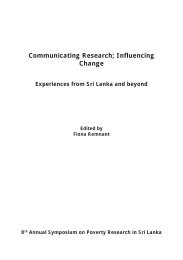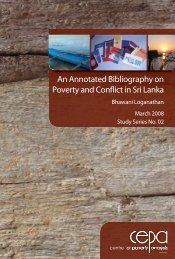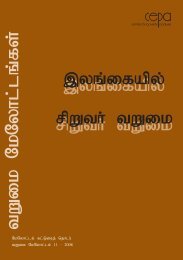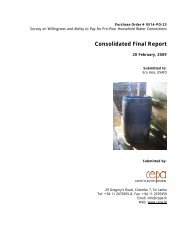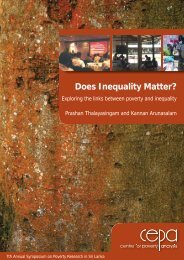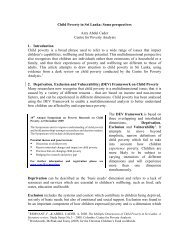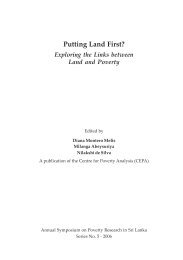Involuntary Displacement and Resettlement â Policy and ... - CEPA
Involuntary Displacement and Resettlement â Policy and ... - CEPA
Involuntary Displacement and Resettlement â Policy and ... - CEPA
- No tags were found...
You also want an ePaper? Increase the reach of your titles
YUMPU automatically turns print PDFs into web optimized ePapers that Google loves.
villages within the project itself, b) Facilitate access to employment in areastargeted to be developed (growth centres) as a result of the developmentproject,c) Provide an employment allowance that would encourage self employment <strong>and</strong>d) Offer structured training in new skills.The international experience of resettlement planning focusing on livelihoodrestoration has influenced the RIP, which incorporates most of the aboverecommendations.4 Livelihoods Restoration in RIPUntil the STDP, resettlement in Sri Lanka was guided by the L<strong>and</strong> AcquisitionAct (LAA) which was amended in 1986. Many resettlement programmes inSri Lanka, the Mahaweli Development Irrigation Program for one, wereimplemented under the LAA. There were gaps in the LAA that needed to beaddressed <strong>and</strong> so the National <strong>Policy</strong> on <strong>Involuntary</strong> <strong>Resettlement</strong> wasdeveloped.The <strong>Resettlement</strong> Implementation Plan (RIP) provides guidelines for therestoration of livelihoods of people affected by the STDP. The RIP, which wasa donor requirement, was developed based on the approved policies of thegovernment, similar to the National <strong>Involuntary</strong> <strong>Resettlement</strong> <strong>Policy</strong> (NIRP).As such, along with guidelines for acquisition <strong>and</strong> compensation, the RIP hasalso developed guidelines for livelihood restoration. This is an important stepforward in involuntary resettlement policy in the country. The RIP offers bothmonetary <strong>and</strong> non monetary assistance to restore livelihoods of the projectaffected. Monetary assistance compensates for the loss of livelihoods in twoways: value for assets <strong>and</strong> allowances for lost livelihoods.The RIP introduces a replacement value over the government valuation ascompensation for assets. The government valuation which was the st<strong>and</strong>ardprocedure was topped with valuations from the LARC 6discussion. Thetop-up valuation is based on the size, geographical location <strong>and</strong> type ofl<strong>and</strong>. On top of the l<strong>and</strong> value, those affected were also eligible to atransaction cost, which took into consideration all costs incurred in physicalrelocation.6LARC = the L<strong>and</strong> Acquisition Reclamation Committee. This committee conducted at DS level isa meeting where the AP <strong>and</strong> the relevant acquisition officials gather to negotiate <strong>and</strong> discuss thecompensation for assets. This was an innovation of the STDP resettlement process.47



